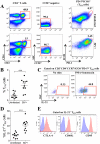Vaccine Induction of Lymph Node-Resident Simian Immunodeficiency Virus Env-Specific T Follicular Helper Cells in Rhesus Macaques
- PMID: 26773147
- PMCID: PMC4744561
- DOI: 10.4049/jimmunol.1502137
Vaccine Induction of Lymph Node-Resident Simian Immunodeficiency Virus Env-Specific T Follicular Helper Cells in Rhesus Macaques
Abstract
Measurement of Ag-specific T follicular helper (TFH) cell activity in rhesus macaques has not previously been reported. Given that rhesus macaques are the animal model of choice for evaluating protective efficacy of HIV/SIV vaccine candidates and that TFH cells play a pivotal role in aiding B cell maturation, quantifying vaccine induction of HIV/SIV-specific TFH cells would greatly benefit vaccine development. In this study, we quantified SIV Env-specific IL-21-producing TFH cells for the first time, to our knowledge, in a nonhuman primate vaccine study. Macaques were primed twice mucosally with adenovirus 5 host range mutant recombinants encoding SIV Env, Rev, Gag, and Nef followed by two i.m. boosts with monomeric SIV gp120 or oligomeric SIV gp140 proteins. At 2 wk after the second protein boost, we obtained lymph node biopsy specimens and quantified the frequency of total and SIV Env-specific IL-21(+) TFH cells and total germinal center B cells, the size and number of germinal centers, and the frequency of SIV-specific Ab-secreting cells in B cell zones. Multiple correlation analyses established the importance of TFH for development of B cell responses in systemic and mucosally localized compartments, including blood, bone marrow, and rectum. Our results suggest that the SIV-specific TFH cells, initially induced by replicating adenovirus-recombinant priming, are long lived. The multiple correlations of SIV Env-specific TFH cells with systemic and mucosal SIV-specific B cell responses indicate that this cell population should be further investigated in HIV vaccine development as a novel correlate of immunity.
Copyright © 2016 by The American Association of Immunologists, Inc.
Figures









References
Publication types
MeSH terms
Substances
Grants and funding
LinkOut - more resources
Full Text Sources
Other Literature Sources

